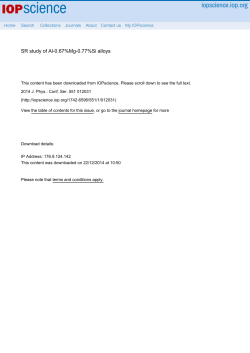
5 GPS (3 points) 6 Quantum mechanic (3 points - kph.Uni
Experimentalphysik 4 Skalen und Strukturen der Materie (SoSe 2015) Prof. Dr. Eva-Maria Kabuß Übungsblatt 2 Abgabe 04.05.15 (in der Vorlesung) 5 GPS (3 points) Watch the video https://youtu.be/ky4RgRvVDoA and answer the following questions: a) Which effects have an influence on the clocks and which one is the dominant one? What is the meaning of these effects for astronauts if they are one the same orbit compared to their colleagues here on earth? b) What is “Trilateration“? 6 Quantum mechanic (3 points) a) Which relation must hold to measure the expectation value of two operators simultaneously? b) Which of the following operators can (not) be measured precisely at the same time? Lz and Lx , x and z, py and x, pz and z, E and t, L2 and Lz , Lx and px , Ly and pz . c) What is the minimum energy of a quantum mechanic oscillator? What is the reason for this? Which energy is the lowest one in the classical case? 7 Cosmic muons (7 points) Muons (mass m = 105.7 MeV/c2 ) are elementary particles, which are produced by cosmic rays in our atmosphere. Typically this takes place at h = 9000 m. The produced muons travel with nearly light speed and have a lifetime of τ = 2.2 µs. a) Explain the terms length contraction and time dilatation? b) Calculate non-relativistic how far a muon can travel before it decays assuming a speed of β = 0.998. Is it possible for a muon to reach the surface of the earth? c) Answer the same question if you perform the relativistic calculation assuming an observer here on earth. d) Assuming an observer travelling with the same speed as the muon what will his explanation be for muons reaching the surface of the earth? e) Determine the relativistic relation between the total energy and momentum. Hint: γ = E/m0 c2 . f) Calculate the centre of mass energy if the muon hits a proton at rest inside the atmosphere. g) Calculate the centre of mass energy if the muon hits a proton with the same momentum. 8 Schrödinger equation (7 points) a) Proof that the wave function Ψ(x) = A · e−αx 2 /2 is a solution of the time independent Schrödinger equation EΨ(x) = − ~2 d2 Ψ(x) + V (x)Ψ(x) 2m dx2 assuming the potential to be the one of a harmonic oscillator V (x) = mω 2 x2 . 2 α is a constant independent of x. Determine also the constant α and the energy E which should be independent of x and is the energy of the ground state. b) Determine the normalisation factor A. c) Calculate the expectation value hxn i of xn where n is an integer larger than zero.
© Copyright 2025











